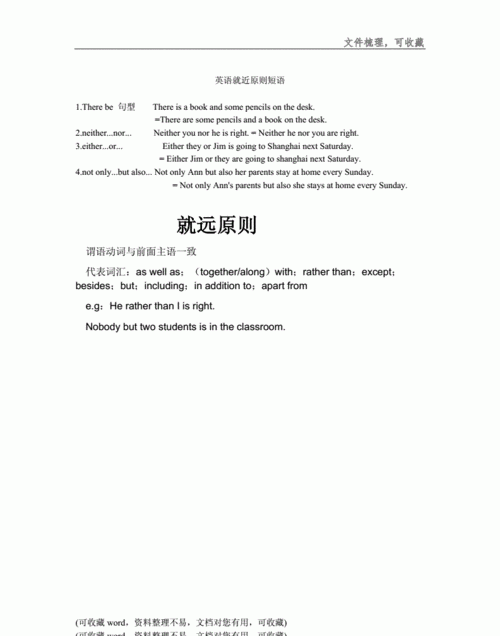本文目录
either or用法就近原则
either… or表示就近原则是在either后加一个主语,or后同时也加一个主语时才适用的。如:Either you or me am

either or 语法
either…or… 或。。。或。。。
不是。。。。就是。。。
表示两者之一,连接句子中两个并列的成分。例如:
例如:
Either you or he has lunch at school. 其一般疑问句应为:Do either you or he have lunch at school? 是你还是他在学校吃午饭?
若要对either...or...句型进行否定时,只需把either...or...换成neither...nor...即可。例如:
Either you or she is good at drawing. 变为否定句应为:Neither you nor she is good at drawing. 你和她都不擅长绘画。
我们还可以单独使用either,其意为"两者中的任何一个"。例如:
There are many shops on either side of the street. 街道两边有许多商店。这个句子也可以这样表达:There are many shops on both sides of the street. 在街道两边有许多商店。
either用在否定句的句末,表示"也"的意思。例如:
If you don\'t go there. I won\'t, either. 如果你不去那里,我也不去。
When the girl is happy, she either sings or dances. 那个女孩高兴时,不是唱就是跳。(此句中either...or...连接两个动词,因为主语是单数第三人称,谓语动词要用其相应的形式。)
either...or...连接两个主语时,其谓语动词应与最近的一个主语在人称和数上保持一致,这就是我们通常说的"就近原则"。
Either you or I am going there tomorrow. 明天要么你去那里,要么我去那里。
注意:如果把上句变成一般疑问句,助动词形式与主语you保持一致,所以要用are提问,而不是am。例如:
Are either you or I going there tomorrow? 明天是你还是我去那里?

either or的就近原则是怎样就近的
either…or…连接两个主语时,其谓语动词应与最近的一个主语在人称和数上保持一致,这就是通常说的"就近原则"。
例如:Either you or I am going there tomorrow. 明天要么你去那里,要么我去那里。
注意:如果把上句变成一般疑问句,助动词形式与主语you保持一致,所以要用are提问,而不是am
例如:Are either you or I going there tomorrow? 明天是你还是我去那里?
Either you or he has lunch at school. 其一般疑问句应为:Do either you or he have lunch at school? 是你还是他在学校吃午饭?
either…or…意为"或者……或者……;不是……就是……"之意。表示两者之一,连接句子中两个并列的成分。例如:
When the girl is happy, she either sings or dances.那个女孩高兴时,不是唱就是跳。(此句中either…or…连接两个动词,因为主语是单数第三人称,谓语动词要用其相应的形式。)

扩展资料
若要对either…or…句型进行否定时,只需把either…or…换成neither…nor…即可。例如:
Either you or she is good at drawing. 变为否定句应为:Neither you nor she is good at drawing. 你和她都不擅长绘画。
还可以单独使用either,其意为"两者中的任何一个"。
例如:There are many shops on either side of the street. 街道两边有许多商店。
或:There are many shops on both sides of the street. 在街道两边有许多商店。
either用在否定句的句末,表示"也"的意思。例如:
If you don't go there. I won't, either. 如果你不去那里,我也不去。
either or就近原则 具体用法是什么
either or在用法上使用就近原则,具体用法是什么?下面我整理了相关内容,来看一下吧!
either or就近原则是什么
就近原则也称“邻近原则”“就近一致原则”,即:谓语与靠近的名词、代词(有时不一定是主语)在“人称、数”上一致。
either…or…“不是……便是……,或者……或者…….”动词与临近的主语保持一致。即 “就近原则”。
Either you or he has to go = Either he or you have to go.
Neither you nor I am right .= Neither I nor you are right.
就近原则是什么
一、由下列词语连接的并列主语:"there be+句型; or ; either …or;nor; neither…nor;whether…or;not…but; not only…but also" ;等。
例句:
1.What he does or what he says does not concern me.
他的行为或言谈都与我无关。
2.Neither you nor I am wrong .
你和我都没错。
二、在倒装句中:谓语可与后面第一个主语一致。
例句:
1. In the distance was heard the clapping of hands and the shouts of the people .
在远处,能听见鼓掌声和人们的呼喊声。
2.There is a pen and some books on the desk.
桌上有一支钢笔和几本书。

以上就是关于Either or的就近原则 ,either or用法就近原则的全部内容,以及Either or的就近原则 的相关内容,希望能够帮到您。

